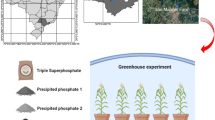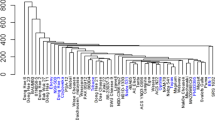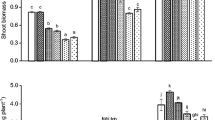Abstract
A main constraint to agricultural productivity in the southern regionsof Chile is the low available soil P exacerbated by the high P sorptioncapacityof the predominant Andisols. Therefore, substantial amounts of P fertilizersmust be applied to obtain optimum growth and crop yields. One cost-effectivestrategy followed to supply P to crops grown in these soils is the directapplication of the local Bahia Inglesa PR source. However, a more sustainablestrategy would be to combine the use of the local PR with the crop species andcultivars that are able to grow in these acid soils and can utilize efficientlyPR. Rape is reported to be very efficient in utilising P from PR sources due toits capacity to exude organic acids to the rhizosphere. Therefore, the presentstudy was conducted to evaluate the ability of five rape cultivars grown in anAndisol of southern Chile in utilising P from two PR sources (Bahia Inglesa andBayovar) and triple superphosphate, a water-soluble P fertilizer. It was foundthat rape was able to absorb significant amounts of P from the PR sources andmuch less from the TSP and soil P. Both Bahia Inglesa and Bayovar PRs werefoundto be as effective as TSP for the rape genotypes in the Andisol Pemehue. Theuseof the 32P isotope technique enabled to assess the ability of thegenotypes tested to utilize P from the different P fertilizers applied. Thegenotypes G2 and G3 showed increased P acquisition from the PR than thegenotypeG5. Combined utilization of P efficient genotypes and direct application of theBahia Inglesa PR seems to be a promising technology for attaining sustainableagricultural productivity in the Andisols of Chile. Further field trials forvalidating these findings at the level of cropping systems are needed. Thisagronomic testing should be accompanied by in-depth studies to assess therelative importance of the morphological and physiological traits determining ahigher P efficiency.
Similar content being viewed by others
References
Allen S.A. 1974. Chemical Analysis of Ecological Materials. Blackwell Scientific Publication. Oxford, England, Oxford, England.
Ankomah A.B., Zapata F., Danso S.K.A. and Axmann H. 1995. Cowpea varietal differences in uptake of phosphorus from Gafsa phosphate rock in a low-P Ultisol. Fert. Res. 41: 219–225.
Baligar V.C. and Duncan R.R. 1990. Crops as enhancers of nutrient use. Academic Press, Inc., San Diego, USA.
Bekele T. and Hofner W. 1993. Effects of different phosphate fertilizers on yield of barley and rape seed on reddish brown soils of Ethiopian highlands. Fert. Res. 34: 243–250.
Carrasco A. and Opazo J. 1995. Predicción de parámetros de respuesta al P de las plantas en función de algunas propiedades químícas en suelos Ultisols and Andisols del Sur de Chile. Agricultura Técnica (Chile) 55: 243–250.
Hammond L.L., Chien S.H. and Mokwunye A.U. 1986. Agronomic value of unacidulated and partially acidulated phosphate rocks indigenous to the tropics. Adv. Agron. 40: 89–140.
Helyar K.R. 1998. Efficiency of nutrient utilization and sustaining soil fertility with particular reference to phosphorus. Field Crops Res. 56: 187–195.
Hocking P.J., Keerthisinghe G., Smith F.W. and Randall P.J. 1997. Comparison of the ability of different crop species to access poorly-available soil phosphorus. In: Ando T. et al. (eds), Plant Nutrition for sustainable food production end environment. Kluwer Academic Publishers, Dordrecht, The Netherlands, pp. 305–308.
Hoffland E., Findenegg G.R. and Nelemans J.A. 1989a. Solubilization of rock phosphate by rape. 1. Evaluation of the role of the nutrient uptake pattern. Plant Soil 113: 155–160.
Hoffland E., Findenegg G.R. and Nelemans J.A. 1989b. Solubilization of rock phosphate by rape. II. Local root exudation of organic acids as a response to P starvation. Plant Soil 113: 161–165.
Khasawneh F.E. and Doll E.C. 1978. The use of phosphate rock for direct application. Adv. Agr. 30: 159–206.
Montenegro A., Besoain E. and Toro C. 1999. Aplicación directa de rocas fosfóricas y mezclas de rocas con fertilizantes fosfatados solubles en el cultivo de raps, en Andisoles de la IX Región. In: Besoain E., Rojas C. and Montenegro A. (eds), Las rocas fosfóricas y sus posibilidades de use en Chile. Instituto de Investigaciones Agropecuarias (INIA), Chile Cap.7.5., pp. 255–270.
Pino I. and Casas L. 1989. Evaluación agronómica de la roca fosfórica de Bahía Inglesa con utlización de técnicas isotópicas. II. Efecto de la aplicación de rocas fosfóricas en tres suelos derivados de cenizas volcánicas en condiciones de invemadero. Nucleotécnica 9: 37–40.
Pino I., Buneder M. and Parada A.M. 1992. Métodos isotópicos en la evaluación de roca fosfórica en condiciones de invernadero. In: Primer Seminario Nacional sobre Uso de Rocas Fosfóricas en Agricultura, 18–20 Noviembre 1992, Temuco, Chile. Instituto Nacional de Investigaciones Agropecuarias, Serie Carillanca No. 29, Chile, pp. 191–200.
Pino I., Montenegro A., Buneder M. and Rodriguez N. 1994. Evaluación agronómica de la fosforita de Bahía Inglesa mediante técncicas isotópicas. Nucleotécnica 14: 53–57.
Randall P.J. 1995. Genotypic differences in phosphate uptake. In: Johansen C., Lee K.K., Sharma K.K., Subbarao G.V. and Kueneman E.A. (eds), Genetic Manipulation of Crop Plants to Enhance Integrated Nutrient Management in Cropping Ssytems. 1. Phosphorus. Proc. of an FAO/ICRISAT Expert Consultancy Workshop. International Crops Research Institute for the Semi-Arid Tropics, Patancheru, Andra Pradesh, India, pp. 31–47.
SAS 1985. SAS Users Guide. Statistical Analysis System Institute, Inc., Cary, North Carolina, USA.
Sattelmacher B., Horst W.J. and Becker H.C. 1994. Factors that contribute to genetic variation for nutrient efficiency of crops plants. Z. Pflanzenernaehr. Bodenk. 157: 215–224.
Tosso J., Instituto de Investigaciones Agropecuarias, Ministerio de Agricultura, Santiago, Chile 1985. Suelos volcánicos de Chile.
Zapata F. 1990. Isotope techniques in soil fertility and plant nutrition studies. In: Hardarson G. (ed.), Use of Nuclear Techniques in Studies of Soil-Plant Relationships. IAEA Training Course Series, Vienna, Austria, pp. 61–128.
Zapata F. and Axmann H. 1995. 32P isotopic techniques for evaluating the agronomic effectiveness of rock phosphate materials. Fert. Res. 41: 189–195.
Zapata F., Pino I., Baherle P. and Parada A.M. 1996. Estudio comparativo de la eficiencia de uso y absorción de fósforo, a partir de fertilizantes fosfóricos, por genotipos chilenos de trigo. Terra. 14: 325–330.
Author information
Authors and Affiliations
Rights and permissions
About this article
Cite this article
Montenegro, A., Zapata, F. Rape genotypic differences in P uptake and utilization from phosphate rocks in an Andisol of Chile. Nutrient Cycling in Agroecosystems 63, 27–33 (2002). https://doi.org/10.1023/A:1020523625712
Issue Date:
DOI: https://doi.org/10.1023/A:1020523625712




